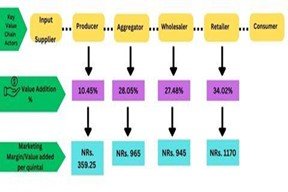Value chain analysis of potato in Bajhang district, Nepal
Abstract
The study was conducted in the Bajhang district from February to July 2022. Its goals were to find the key actors in the potato value chain, assess their linkage, analyse marketing margins, determine the share of value-addition among each actor, evaluate the production cost, productivity, and profitability of producers, examine the producer’s share in consumer rupees, and conduct a SWOT analysis. The data collection process involved the random purposive sampling technique to select a total of 80 potato producers, 5 aggregators, 5 wholesalers, 10 retailers, 50 consumers, and 3 extension service providers. Findings revealed that, on average, potato cultivation covered 0.215 hectares (4.23 Ropani) with a productivity of 13.46 Mt/ha, which is lower than the national average. The production cost of the producer was NRs. 301,756.60/Ha (NRs. 15,356.57/Ropani) with a benefit-cost ratio of 1.37, and the producer’s share was 51.68%. The primary value chain actors included input suppliers, producers, aggregators, wholesalers, retailers, and consumers. Marketing margins for producers, aggregators, wholesalers, and retailers were NRs. 359.25/quintal, NRs. 965/quintal, NRs. 945/quintal, and NRs. 1170/quintal, respectively. Value addition by potato producers accounted for 10.45%, while aggregators, wholesalers, and retailers contributed 28.05%, 27.48%, and 34.02%, respectively. The SWOT analysis highlighted opportunities like favourable policies, subsidies, processing options, rising potato demand, and potential production area expansion. To boost the profitability of the potato industry, it is imperative to address challenges such as poor seed quality, diseases-pests, drought, short shelf life, soil degradation, and fertilizer and pesticide availability while strengthening the linkage of value chain actors.
Keywords:
Marketing margin, Price spread, SWOT analysis, Value chain map, Value additionDownloads
References
Bajracharya, M., & Sapkota, M. (2017). Profitability and productivity of potato (Solanum tuberosum) in Baglung district, Nepal Agriculture and Food Security, 6(1), 2–9, https://doi.org/10.1186/s40066-017-0125-5
Bolakhe, K., Hari Dhakal, K., Nepal, S., & Dahal, R. (2022). Economic Analysis of Potato Basic Seed Production Under Contract Farming in Kavrepalanchok, Nepal International Journal of Agricultural Economics, 7(1), 4. https://doi.org/10.11648/j.ijae.20220701.12
CBS. (2013). Statistical Year Book of Nepal-2013. Government of Nepal, National Planning Commission Secretariat. Central Bureau of Statistics, Kathmandu.
CBS. (2021). National Population and Housing Census 2021. Central Bureau of Statistics.
Chauhan, B., Joshi, D., Banjade, D., Bhatta, B. D., Awasthi, P., Paneru, M., Shrestha, M., & Chand, P. B. (2022). Economics of potato (Solanum tuberosum L.) production and marketing in Darchula district of Nepal. Archives of Agriculture and Environmental Science, 7(3), 393–401, https://doi.org/10.26832/24566632.2022.0703013
Dhital, B. (2017). Economy of Production and Labor Requirement in Major Field Crops of Kavre, Nepal. International Journal of Environment, Agriculture and Biotechnology, 2(1), 350–353, https://doi.org/10.22161/ijeab/2.1.43
Emana, B., & Nigussie, M. (2011). Potato Value Chain Analysis and Development in Ethiopia. 1–82, http://sweetpotatoknowledge.org/projects-initiatives/better-potato-for-a-better-life/resources/potato-value-chain-analysis-and-development-in-ethiopia.pdf
FAOStat. (2020). Food and Agriculture Organization Statistics (FAOStat). https://www.helgilibrary.com/indicators/potato-consumption-per-capita/nepal/
Gujarati, D. N., & Porter, D. C. (2013). Basic Econometrics, Fifth Edition. In Introductory Econometrics: A Practical Approach.
Kassaye, T., Luc, D., & Pascal, B. (2018). Analysis of coffee quality along the coffee value chain in Jimma zone, Ethiopia. African Journal of Agricultural Research, 13(29), 1468–1475, https://doi.org/10.5897/AJAR2018.13118
Miller, C., & Jones, L. (2010). Agricultural Value Chain Finance. Practical Action Publishing. https://doi.org/10.3362/9781780440514
MoALD. (2023). Statistical Information on Nepalese Agriculture 2077/2078 (2020/21). Government of Nepal, Ministry of Agriculture and Livestock Development, Planning and Development Cooperation Coordination Division, Statistics and Analysis Section, Kathmandu, Nepal. https://moald.gov.np/wp-content/uploads/2022/07/STATISTICAL-INFORMATION-ON-NEPALESE-AGRICULTURE-2077-78.pdf
Nassirou Ba, M. (2016). Strategic Agricultural Commodity Value Chains in Africa for Increased Food: The Regional Approach for Food Security. Agricultural Sciences, 07(09), 549–585, https://doi.org/10.4236/as.2016.79055
Phulara, B., Acharya, B., Adhikari, S., Ojha, B., & Sigdel, U. P. (2022). Production Economics and Marketing of Potato in Okhaldhunga, Nepal. Food and Agri Economics Review, 2(1), 26–33, https://doi.org/10.26480/faer.01.2022.26.33
Sakha, B. M., Rai, G. P., Dhital, S. P., & Nepal, R. B. (2007). Disease-free Pre-Basic Seed Potato Production through Tissue Culture in Nepal. In Nepal Agriculture Research Journal (Vol. 8).
Sapkota, S. C., Rokaya, P. R., Acharya, H., & Uprety, S. (2019). An Economic Analysis of Potato Production in AchhaM District of Nepal. International Journal of Horticulture & Agriculture, 4(2), 1–9, https://doi.org/10.15226/2572-3154/4/2/00131
Shrestha, K., & Yadav, S. (2018). Value Chain Analysis of Potato in Ilam District, Nepal. South Asian Journal of Social Studies and Economics, 1–13, https://doi.org/10.9734/sajsse/2018/v2i325861
Shrestha, S., Shrestha, R., Paudel, A., Paudel, A., Gurung, B., & Poudel, U. (2022). Value Chain Analysis of Potato in Tokha Municipality of Kathmandu District, Nepal. Economic Growth and Environment Sustainability, 1(1), 19–31, https://doi.org/10.26480/egnes.01.2022.19.31
Subedi, S., Ghimire, Y. N., Gautam, S., Poudel, H. K., & Shrestha, J. (2019). Economics of potato (Solanum tuberosum L.) production in the Terai region of Nepal. Archives of Agriculture and Environmental Science, 4(1), 57–62, https://doi.org/10.26832/24566632.2019.040109
Tadesse, B., & Bakala, F. (2018). Value Chain Analysis of Potato: The Case of Sheka Zone, Southwest Ethiopia. International Journal of Horticulture & Agriculture, 3(1), 1–10, https://doi.org/10.15226/2572-3154/3/1/00117
Upadhyay, K. P., & Timilsina, A. P. (2020). Bung: A traditional practice of potato cultivation in eastern hills of Nepal. Journal of Agriculture and Natural Resources, 3(1), 38–50, https://doi.org/10.3126/janr.v3i1.27004
Zamora, E. A. (2016). Value Chain Analysis: A Brief Review. Asian Journal of Innovation and Policy, 5(2), 116–128, https://doi.org/10.7545/ajip.2016.5.2.116

Published
How to Cite
Issue
Section
Copyright (c) 2023 Agriculture and Environmental Science Academy

This work is licensed under a Creative Commons Attribution-NonCommercial 4.0 International License.

